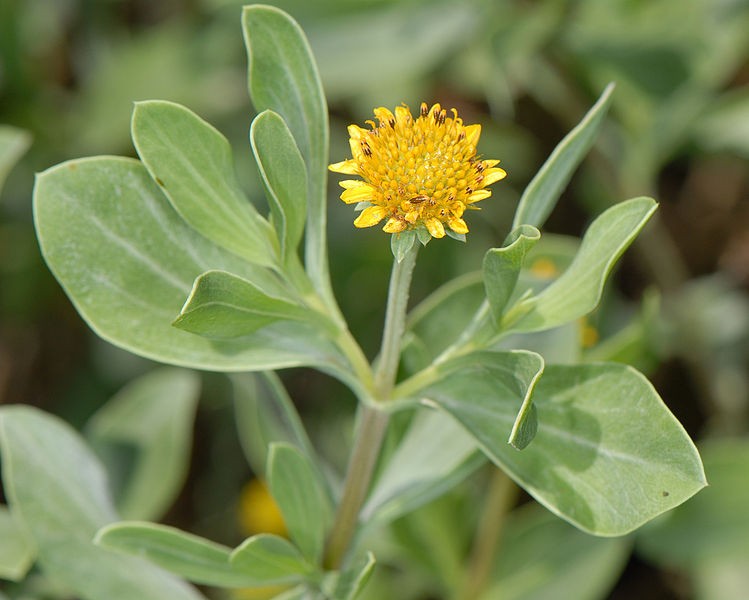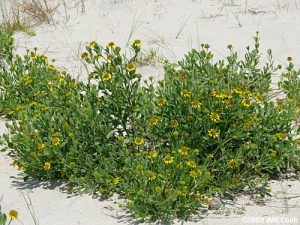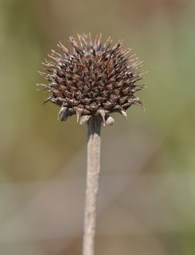
Sea Oxeye: Note the pointed green bracts directly below the yellow blossom. They are key to identification.
There are edible plants, and there are non-edible plants. Then there are those that sit on the cusp of edibility: Edible but not tasty, edible in small quantities, edible but with a horrible texture, edible but strong-flavored. That’s where one finds the bitter Borrichia frutescens, aka Bushy Seaside Tansy, Sea Oxeye, Bushy Seaside Oxeye, Sea Marigold and many other names in several languages. What can you eat? Leaves cooked or raw.

Typical Sea Oxeye display on the beach.
In his 909-page book Forida Ethnobotany Professor Daniel Austin managed to scraped up about one page worth of information on B. frutescens or what he called the Sea Oxeye. He begins by by describing the plants as colorful in salty area, both yellow blossoms and different hued leaves. He then descends into the common lament that two species (B. frutescens and B. arborescens) have been much confused in botanical literature. He notes that both were probably used the same way medicinally. The first medical reference to them is in the 1400’s. Uses include “boiling the leafy branches and talking the decoction for colds and coughs.” That same tea was also used for whooping cough, back pain, colds, chest complaints, asthmas and malaria. Most unusually an infusion of the leaves was widely considered an antidote for eating poisoned fish (ciguaterra.)

Sea Oxeye’s single blossom gone to seed.
Some references say both species have been used for food — or — folks have eaten one thinking it was the other. That’s a bit iffy as the two species are reasonably easy to tell apart — if that is your goal. They both have a bracts (leaf or petal-like growths directly below the blossom.) If the bracts are rigid and tipped with a spine they are B. frutescens. If the bracts are soft and not tipped with a spine they are B. arborescens. Also B. frutescens has gray leaves, B. arborescens green leaves in Florida. Elsewhere they can mix and match. There is a third species as well, B. xcubana. It’s labeled rare and is found in Miami-Dade and Monroe counties (extreme south Florida and the Keys.) Austin reports that B. xcubana is a hybrid between the two aforementioned species. Its leaves are intermediate in color — like both parents — and spines on the bracts are soft.
As for edibility the references are sparse. Cornucopia II reports for the B. frutescens: “The leaves are apparently eaten in salads or as a potherb.” Julia Morton did not mention the species in her book “Wild Plants for Survival in South Florida.”
Green Deane Itemized Plant Profile
Identification: Stems usually erect, sometimes decumbent or arching. Leaves (at least mid-cauline) obovate or elliptic to oblanceolate. The single flowering head of is found on the ends of the main stem or branches of the plant. The ray flowers are yellow and the central disc flowers are brownish yellow. The heads are mature when the yellow ray flowers have fallen off, and the central disc flowers become dark brown and very hard and sharp to the touch. Each disc flower produces a dark brownish-gray indehiscent (closed) dried fruit, an achene containing a single seed. The achene is short, 0.12-0.16″ and cone-shaped with three to four angles, each tipped with a sharp tooth.
Time of year: Flowers in late spring and or summer.
Environment: It is found in salt marshes, along dunes, at the wrack line and or in brackish locations. If covered by the wrack line it recovers quickly. Sea Oxeye grows on coasts from Virginia to the Yucatan Peninsula and also inland along the Rio Grande Vally. It is also found in the Florida Keys and has been introduced to Bermuda, the Bahamas and Cuba.
Method of Preparation: Leaves raw (usually with vinegar in a salad) or cooked as a pot herb.


There is a lot of it in my area. I saw sheep enjoying it and used picture this app to know what kind of a plant it is. So I find out that it’s good for cough and want to use it.